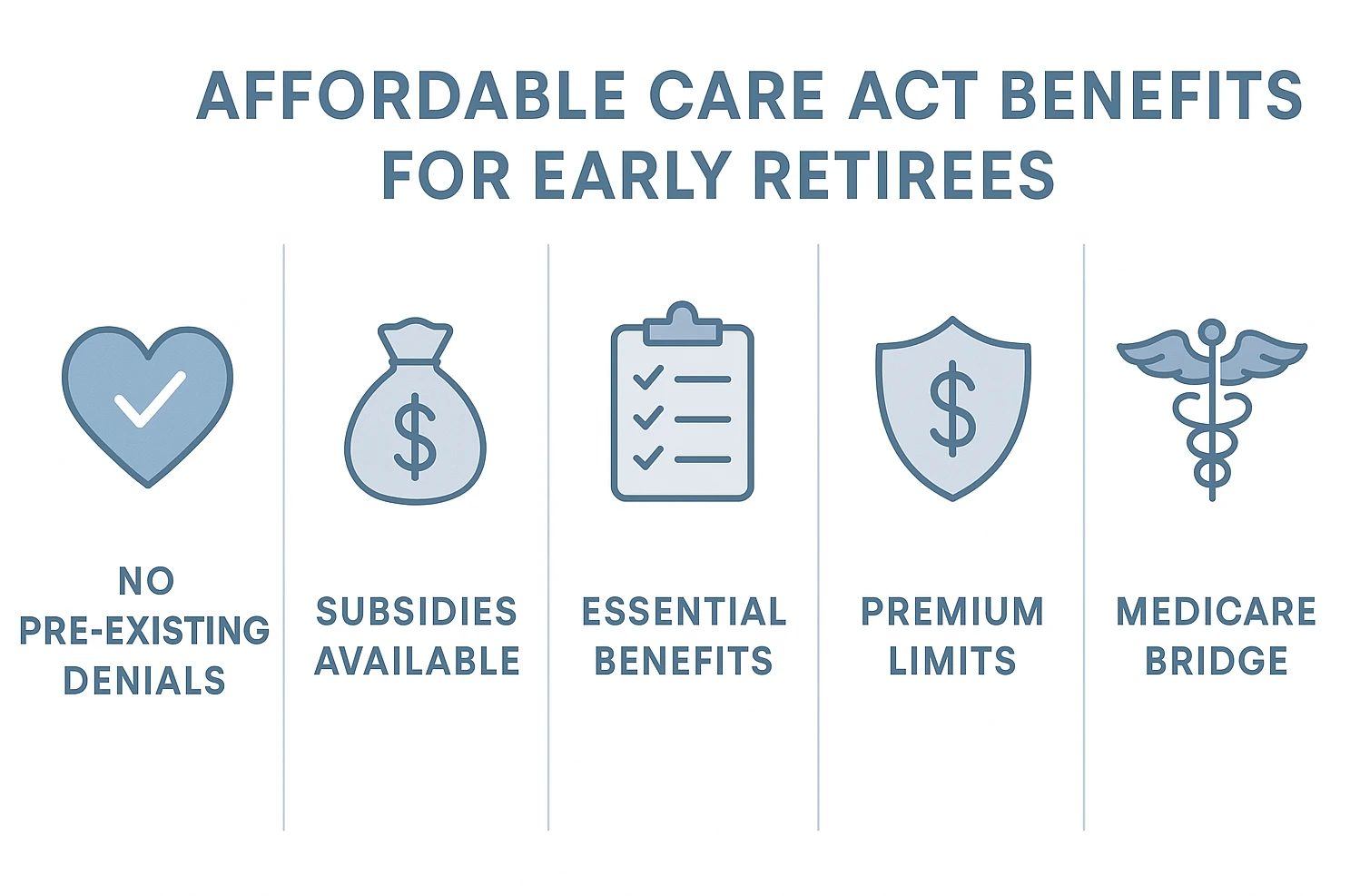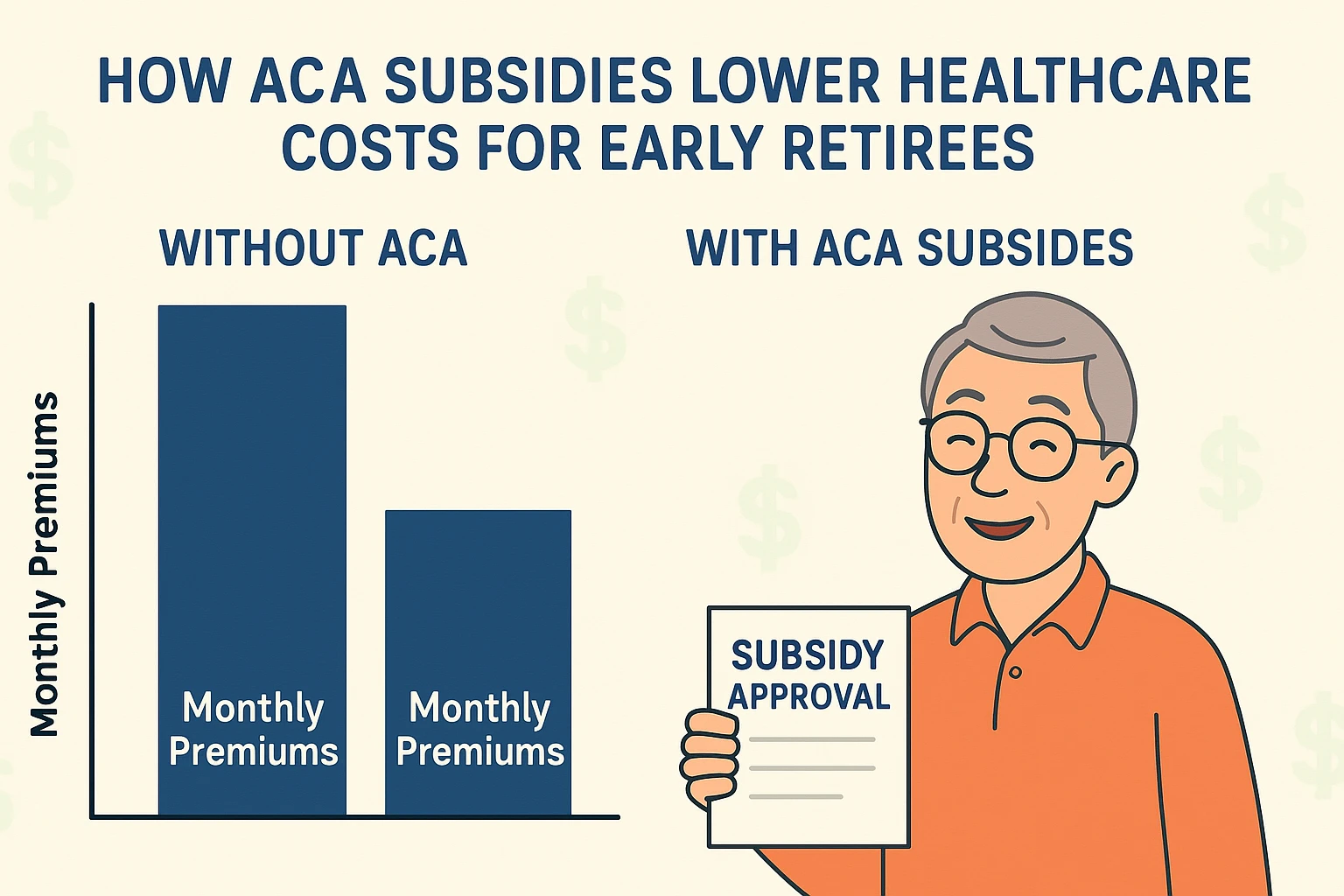
Thinking about retiring early? The early retirement affordable care act (ACA) makes staying covered doable without blowing up your budget. Leaving the workforce before 65 is a thrilling leap toward living life on your terms, especially with frugal retirement strategies. But let’s be real—one big worry pops up: “How am I going to handle healthcare?” 😕 Luckily, the Affordable Care Act offers affordable, high-quality insurance, often with meaningful financial help.
Table of Contents
- Key Takeaways for Early Retirement Affordable Care Act
- Why the ACA Matters for Early Retirees
- Eligibility for ACA Plans
- Maximizing Subsidies with the Early Retirement Affordable Care Act
- Navigating the ACA Marketplace
- ACA Subsidy Estimator Tool
- Tax Implications for the Early Retirement Affordable Care Act
- Case Study: Sarah’s Early Retirement Journey
- Bridging to Medicare
- Tips for a Smooth ACA Experience
- Frequently Asked Questions
- Conclusion
Key Takeaways for Early Retirement Affordable Care Act
- ACA as a Bridge: The Affordable Care Act fills the healthcare gap for early retirees until Medicare eligibility at age 65.
- Subsidies Save Money: Premium Tax Credits (PTCs) and Cost-Sharing Reductions (CSRs) can significantly lower premiums and out-of-pocket costs.
- Income Planning: Your Modified Adjusted Gross Income (MAGI) determines subsidy eligibility, so strategic financial planning is crucial.
- Enrollment Timing: Enroll during the Open Enrollment Period (OEP) or qualify for a Special Enrollment Period (SEP) after retirement.
- Choose Wisely: Select a plan (Bronze, Silver, Gold, Platinum) that balances premiums and out-of-pocket costs based on your needs.
Why the ACA Matters for Early Retirees
When you retire before 65, employer-sponsored health insurance typically ends, leaving a gap until Medicare kicks in. This is where ACA coverage for early retirees becomes essential. The ACA lets you shop for plans on Healthcare.gov, and it throws in subsidies to keep your coverage easy on the wallet, even without your boss chipping in.

Benefits of the Early Retirement Affordable Care Act 🩺
Here’s why the ACA has been a total lifesaver for early retirees like me:
- Guaranteed Coverage: No matter what’s in your medical history, ACA plans won’t shut you out or hike up costs for pre-existing conditions. It’s such a weight off my shoulders knowing I’m covered, no hassle.
- Essential Health Benefits: Plans cover doctor visits, hospital care, prescriptions, mental health, maternity, and preventive services.
- Financial Assistance: Subsidies like Premium Tax Credits and Cost-Sharing Reductions make ACA coverage in early retirement a reality for many.
- Age-Based Fairness: Premiums for older adults are capped at three times those for younger ones, preventing excessive costs.
- Medicare Bridge: The ACA seamlessly covers you until Medicare eligibility at 65.
ACA vs. Other Options
Let’s compare the ACA to alternatives for early retirees:
| Option | Pros | Cons | ACA Advantage |
|---|---|---|---|
| COBRA | Keeps your employer plan | Very expensive ($1,500-$3,000+/month), temporary (18-36 months) | ACA is more affordable with subsidies, offers long-term coverage |
| Short-Term Plans | Low premiums | Not ACA-compliant, limited coverage, denies pre-existing conditions | ACA offers comprehensive coverage and subsidies |
| Private Plans (Off-Marketplace) | Some flexibility | No subsidies, high premiums | ACA marketplace plans are cost-effective with financial help |
Insight: The Affordable Care Act is often the most cost-effective and comprehensive solution for early retirees, thanks to its robust subsidies and consumer protections.
Eligibility for ACA Plans
To enroll in an ACA plan and access subsidies, you must meet these criteria:
- Residency: Live in the United States.
- Citizenship: Be a U.S. citizen, national, or lawfully present immigrant.
- No Incarceration: Not be incarcerated.
- No Medicare: Not be eligible for Medicare (available at 65).
Enrollment Windows for ACA in Early Retirement
Timing is critical for enrollment:
- Open Enrollment Period (OEP): Runs from November 1 to January 15 for coverage starting the next year. Enroll by December 15 for January 1 coverage, or by January 15 for February 1.
- Special Enrollment Period (SEP): Qualifying life events, like losing employer coverage due to retirement, grant a 60-day window to enroll. Other events include marriage, divorce, or moving.
Tip: If retiring mid-year, apply for an SEP immediately after your employer coverage ends to avoid gaps.
Maximizing Subsidies with the Early Retirement Affordable Care Act
The ACA really shines for early retirees through its subsidies, which act like a financial thermostat, adjusting costs to your income. With some smart budgeting habits, you can optimize your Modified Adjusted Gross Income (MAGI) to maximize these savings. Let’s break down the two main types.
Premium Tax Credits (PTCs) 💰
PTCs lower your monthly premiums, paid directly to your insurer. Your subsidy depends on your MAGI, household size, and local plan costs. For instance:
- Expanded Subsidies: Thanks to the American Rescue Plan Act (2021) and Inflation Reduction Act (2022), there’s no income cap for PTCs through 2025. For a standard Silver plan, your premiums are capped at 8.5% of your income, thanks to those handy subsidies.
- Low-Income Benefits: Incomes below 150% of the Federal Poverty Level (FPL) may get $0 premiums.
MAGI Explained: Your MAGI includes Adjusted Gross Income plus tax-exempt interest, non-taxable Social Security, and excluded foreign income. For early retirees, managing withdrawals from taxable accounts or Roth conversions is key to optimizing subsidies.

Cost-Sharing Reductions (CSRs) 📉
CSRs reduce out-of-pocket costs like deductibles and co-pays, but only for Silver plans and incomes between 100-250% FPL. Consequently, Silver plans often offer better value than Gold or Platinum for eligible retirees.
Strategies to Optimize MAGI
Smart financial planning can maximize your subsidies:
- FIRE Strategies: Use taxable accounts for low-tax capital gains or tax-free Roth withdrawals to keep MAGI low.
- Roth Conversions: Plan small conversions to avoid spiking MAGI, balancing tax brackets and subsidies.
- Part-Time Income: Monitor side hustle earnings, as they increase MAGI, and update the marketplace promptly.
Pro Tip: Strategically managing your MAGI is like tuning a radio—find the sweet spot to maximize your ACA subsidies in early retirement.
Navigating the ACA Marketplace
The marketplace, such as Healthcare.gov or state-specific platforms like Covered California, is your hub for ACA plans tailored to early retirees. It’s a key part of exploring early retirement health insurance options. Here’s how to enroll effectively.
Enrollment Steps
- Create an Account: Visit Healthcare.gov or your state’s marketplace.
- Enter Details: Provide household size, estimated MAGI, and current coverage status.
- Browse Plans: Compare plans with subsidies applied, focusing on premiums and cost-sharing.
- Compare Tiers: Understand metal levels (Bronze, Silver, Gold, Platinum) and their cost structures.
- Enroll: Select a plan and pay the first premium to activate coverage.
Plan Tiers Comparison
| Tier | Premium | Deductible | Best For |
|---|---|---|---|
| Bronze | Lowest | Highest | Healthy individuals needing catastrophic coverage |
| Silver | Moderate | Moderate (lower with CSRs) | Those eligible for CSRs or balanced needs |
| Gold | Higher | Lower | Frequent medical needs |
| Platinum | Highest | Lowest | High medical usage |
ACA Subsidy Estimator Tool
Estimate your savings on an ACA plan in early retirement.
ACA Subsidy Estimator
Input your details to see potential savings based on your situation.
Your Estimated Results
*Disclaimer: This tool provides an estimate based on 2024 FPL and average premiums. Actual costs vary by location and plan. Visit Healthcare.gov for exact figures.
Tax Implications for the Early Retirement Affordable Care Act
Understanding tax implications is crucial for maximizing ACA benefits in early retirement, especially with fluctuating retirement income.
Reconciling Premium Tax Credits
Advance Premium Tax Credits (APTCs) are paid to your insurer during the year. At tax time, you reconcile these using Form 8962. For example:
- Lower MAGI: If your actual MAGI is lower than estimated, you may receive a refundable tax credit.
- Higher MAGI: If your MAGI is higher, you might repay some subsidies, but the Inflation Reduction Act (2022) limits repayment through 2025.
Estimating Income Accurately
Since early retirees often lack W-2 income, estimate MAGI from sources like taxable withdrawals, capital gains, and rental income. Update the marketplace if your income changes to avoid surprises.
Tax-Efficient Withdrawal Strategies
Optimize your income flow to keep MAGI in the subsidy sweet spot:
- Roth Conversions: Convert small amounts to avoid spiking MAGI.
- Taxable Accounts: Use capital gains (often 0% tax at low incomes) to generate income without losing subsidies.
- Health Savings Accounts (HSAs): Contribute to HSAs for tax-deductible savings, using withdrawals for medical expenses.
Case Study: Sarah’s Early Retirement Journey
Sarah, a 58-year-old retiree, left her job to chase her dream of traveling. Worried about healthcare costs, she leaned on ACA coverage during early retirement and tools like a Coast FIRE calculator to plan her finances. By keeping her MAGI at $35,000 through taxable account withdrawals, she snagged a Silver plan with a $200 monthly premium after subsidies, plus CSRs that slashed her deductible. This saved her thousands yearly, letting her retire with confidence.

Bridging to Medicare
The ACA carries you until Medicare at 65. Here’s how to transition smoothly:
- Sign Up for Medicare: Jump into Medicare during your 7-month Initial Enrollment Period, which spans 3 months before and after your 65th birthday.
- Automatic vs. Active Enrollment: If receiving Social Security, you’re auto-enrolled in Parts A and B. Otherwise, enroll via the Social Security Administration.
- Avoid Penalties: Sign up for Part B and Part D on time to avoid permanent penalties.
Tip: Notify the marketplace of your Medicare start date to end your ACA plan seamlessly.
Tips for a Smooth ACA Experience
Maximize your ACA journey in early retirement with these strategies:
- Accurate Income Estimates: Update the marketplace if income changes to avoid repayment issues.
- Check Networks: Ensure your doctors are in-network to avoid high costs.
- Make the Most of Preventive Care: Take full advantage of free check-ups and screenings—keeping healthy has never been easier!
- Leverage HSAs: Contribute to HSAs for tax-free medical savings.
- Seek Expert Advice: Consult a financial planner for complex income strategies.
Frequently Asked Questions
Conclusion
The early retirement affordable care act empowers you to retire early without healthcare worries. By leveraging subsidies, managing MAGI, and choosing the right plan, you can bridge to Medicare affordably. Start exploring ACA options today to secure your health and financial freedom! ✅
This content is for informational purposes only and not financial advice. Consult a professional before making financial decisions.

